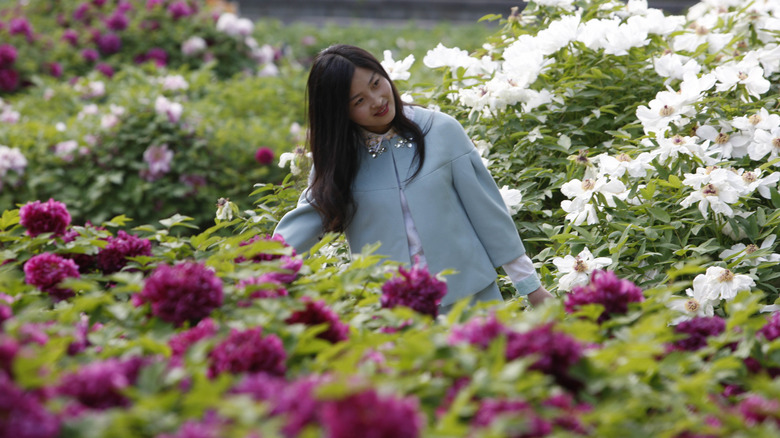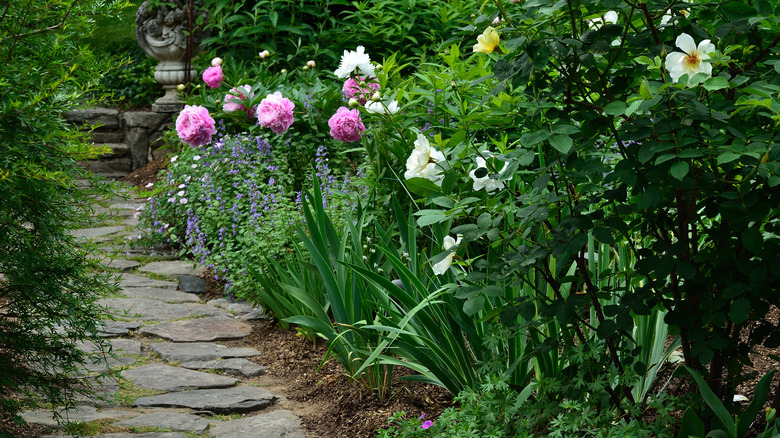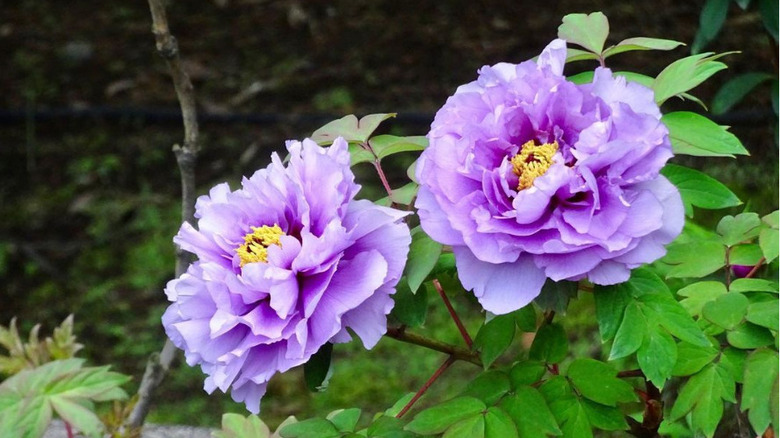Martha Stewart Explains The Difference Between Tree Peonies And Herbaceous Peonies
In a video shared on Martha Stewart's Facebook page, the DIY garden expert and businessperson takes viewers on a tour through "the secrets" of her home garden. "As I put plants in and take plants out, it's gotten to have a color scheme that's unique to itself," she says. Stewart points out some of her favorite colorful plants like poppies, alliums, and iris before turning to a bush with large white flowers.
"And here, just a little bit past their prime but still as glorious as could possibly be, the tree peony," Stewart exclaims. However, she also warns that not all peonies are the same. "These are really trees. Look how tall this is, very unlike the herbaceous peony that is so familiar to all of us," she says in the video. Stewart's observation is correct; tree peonies tend to be much taller than herbaceous peonies and are distinguishable by their woodier stems and pronged leaves.
The tree peony is one of Martha Stewart's favorite garden plants and one that any gardener will look forward to seeing in glorious bloom every year. Still, it's essential to understand the differences between tree and herbaceous cultivars when planning to grow peonies in your garden.
Identifying tree peonies and herbaceous peonies
Despite being slightly different plants, both tree and herbaceous peonies originated in East Asia. "They originated in China and then were hybridized a lot in Japan," Stewart says, via Facebook. Because of this hybridization, tree and herbaceous peonies may also appear different depending on the country they reign from. "Chinese tree peonies are more robust and bushy. Their flowers are also more likely to be fragrant," Stewart writes (via The Martha Blog). "Japanese types, by contrast, are renowned for their beauty and elegance."
The easiest way to identify tree peonies is by height. While herbaceous peonies typically stand about 2 to 3 feet tall, tree peonies reach between 4 and 5 feet when fully mature. Young tree peonies can also be recognized by their thick wood-like stems that last year-round. On the other hand, herbaceous peonies are perennials that fade away and hide underground during winter.
Leaves and blooms can also be distinguishing marks of the tree peony. "Tree peony leaves are easily distinguished from herbaceous peonies by their dissected three-pronged appearance," Stewart explains. "The tree peony, Paeonia suffruticosa, has upright flowers that bloom above the foliage ... And, unlike the more common herbaceous peonies, which flop over if not staked, tree peonies bloom on graceful woody stems."
Caring for tree peonies
Tree and herbaceous peonies have similar care needs, but the best plant for you may depend on your environment. Herbaceous peonies like rich and thick clay soil, but Stewart recommends (via Facebook), "If you have a spot that is partially shade, and a rich, deep, undisturbed soil, try one of these fantastic tree peonies." Herbaceous peonies require cool temperatures and cold winters to bloom, but tree peonies can thrive in temperate but slightly warmer conditions. Both types prefer full sun for at least 5 hours every day, with shady protection during hot afternoons.
Tree peonies may be the more low-maintenance option, as they don't require you to install support frames or tend to the plant often. In fact, Stewart advises that to grow peonies successfully, you must not over-groom them. "Tree peonies should not be cut back," she writes on The Martha Blog. "Tree peonies are very slow growing and will not send forth new growth if pruned. The only cutting should be to remove any dead branches."
Once established, these gorgeous plants can live for up to a century, beautifying your garden from late April to early May. "Every year, these shrubs become more and more prolific, producing large flowers," Stewart explains on her blog. "Unfortunately, the tree peony season is short – only about seven to 10 days – so I make sure not to miss them when they flower."


